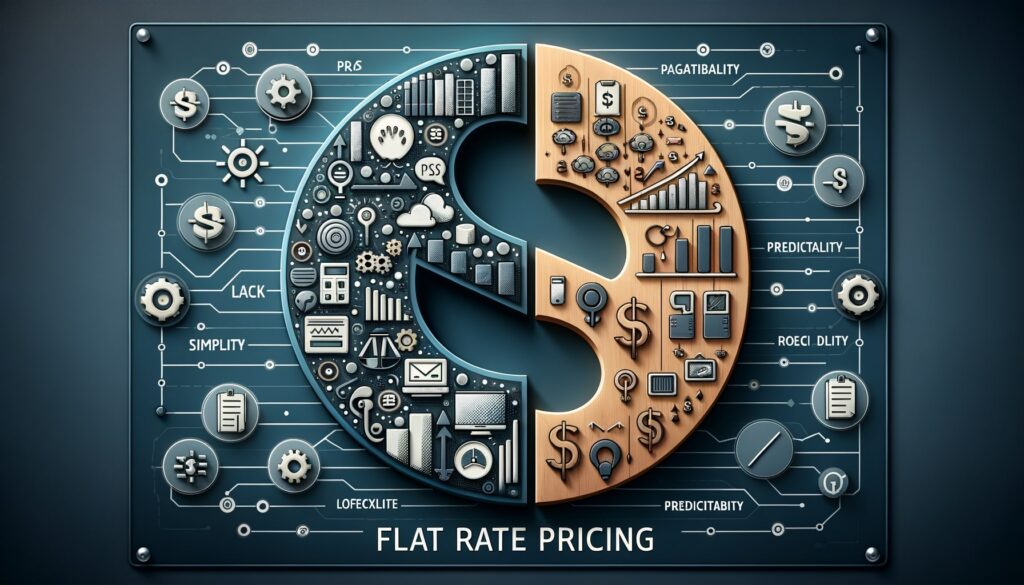
By American November 19, 2024
Payment processing is an essential aspect of any business that accepts electronic payments. Whether you run an online store, a brick-and-mortar shop, or a service-based business, having a reliable and efficient payment processing system is crucial for your success. When it comes to payment processing, there are two primary pricing models: flat rate and interchange plus.
In this article, we will explore the pros and cons of each pricing model, discuss the key differences between them, and provide guidance on choosing the right pricing model for your business.
Flat Rate Pricing: Pros and Cons
Flat rate pricing is a straightforward pricing model where merchants pay a fixed percentage or a flat fee for each transaction, regardless of the card type or transaction amount. This pricing model is popular among small businesses and startups due to its simplicity and predictability. Here are some pros and cons of flat rate pricing:
Pros
- Simplicity: Flat rate pricing is easy to understand and calculate. Merchants don’t have to worry about complex fee structures or deciphering interchange rates.
- Predictability: With flat rate pricing, merchants know exactly how much they will be charged for each transaction, making it easier to budget and forecast expenses.
- No monthly fees: Many flat rate pricing plans don’t require monthly fees, making it an attractive option for businesses with low transaction volumes.
- Quick setup: Flat rate pricing plans are often easy to set up, allowing businesses to start accepting payments quickly.
Cons
- Higher costs for high-volume businesses: Flat rate pricing may not be cost-effective for businesses with high transaction volumes. The fixed percentage or flat fee can add up quickly, resulting in higher overall costs.
- Lack of transparency: Flat rate pricing plans often bundle various fees into a single rate, making it challenging to determine the exact breakdown of costs.
- Limited customization: Flat rate pricing plans may not offer the flexibility to customize pricing based on specific business needs or transaction types.
Interchange Plus Pricing: Pros and Cons
Interchange plus pricing, also known as cost-plus pricing, is a more complex pricing model that provides transparency by separating interchange fees from the processor’s markup. Under this model, merchants pay the actual interchange fee set by the card networks, plus a fixed markup fee from the payment processor. Here are some pros and cons of interchange plus pricing:
Pros
- Transparency: Interchange plus pricing offers transparency by clearly separating interchange fees from the processor’s markup. Merchants can see the exact cost of each transaction, allowing for better cost analysis and negotiation.
- Cost savings for high-volume businesses: Interchange plus pricing can be more cost-effective for businesses with high transaction volumes. By paying the actual interchange fee, merchants can avoid overpaying for lower-cost transactions.
- Customization: Interchange plus pricing allows businesses to customize pricing based on transaction types, card types, and other factors. This flexibility can result in lower costs for specific types of transactions.
- Better negotiation power: With interchange plus pricing, merchants have more leverage to negotiate rates with payment processors, as the interchange fees are standardized and transparent.
Cons
- Complexity: Interchange plus pricing can be more complex to understand and calculate compared to flat rate pricing. Merchants need to have a good understanding of interchange fees and the processor’s markup to accurately assess costs.
- Potential for hidden fees: While interchange plus pricing offers transparency, some payment processors may still include additional fees or markups that are not clearly disclosed. Merchants should carefully review the terms and conditions to avoid unexpected costs.
- Monthly fees: Interchange plus pricing plans often include monthly fees, which can be a disadvantage for businesses with low transaction volumes or seasonal fluctuations.
Key Differences Between Flat Rate and Interchange Plus Pricing
The key differences between flat rate and interchange plus pricing lie in their fee structures and cost calculations. Here are the main distinctions:
- Fee structure: Flat rate pricing typically charges a fixed percentage or flat fee for each transaction, regardless of the card type or transaction amount. Interchange plus pricing separates the interchange fee, which is set by the card networks, from the processor’s markup fee.
- Cost calculation: With flat rate pricing, the cost of each transaction is predictable and easy to calculate. Interchange plus pricing requires merchants to calculate the interchange fee based on the card type and transaction details, and then add the processor’s markup fee.
- Transparency: Flat rate pricing plans often bundle various fees into a single rate, making it challenging to determine the exact breakdown of costs. Interchange plus pricing offers transparency by separating interchange fees from the processor’s markup, allowing merchants to see the actual cost of each transaction.
- Customization: Flat rate pricing plans typically offer limited customization options, while interchange plus pricing allows businesses to customize pricing based on transaction types, card types, and other factors.
Factors to Consider When Choosing Between Flat Rate and Interchange Plus Pricing
When deciding between flat rate and interchange plus pricing, several factors should be taken into consideration. Here are some key factors to consider:
- Transaction volume: If your business has a high transaction volume, interchange plus pricing may be more cost-effective, as it allows you to pay the actual interchange fee for each transaction. Flat rate pricing, on the other hand, may result in higher overall costs for high-volume businesses.
- Transaction types: Consider the types of transactions your business typically processes. If you have a mix of low-cost and high-cost transactions, interchange plus pricing can help you save money by paying the actual interchange fee for each transaction. Flat rate pricing may not offer the same level of cost optimization for different transaction types.
- Card types: Different card types, such as debit cards, credit cards, and rewards cards, have varying interchange fees. Interchange plus pricing allows you to pay the actual interchange fee for each card type, while flat rate pricing may charge a fixed percentage or fee regardless of the card type.
- Business size and budget: Consider your business size and budget when choosing a pricing model. Flat rate pricing is often favored by small businesses and startups due to its simplicity and predictable costs. Interchange plus pricing may be more suitable for larger businesses with higher transaction volumes and the ability to negotiate rates.
Understanding Interchange Fees: How They Impact Pricing Models
Interchange fees are fees paid by merchants to the card networks (Visa, Mastercard, etc.) for each transaction. These fees are set by the card networks and vary based on factors such as card type, transaction type, and industry. Interchange fees play a significant role in determining the cost of payment processing and can impact pricing models like flat rate and interchange plus. Here’s how interchange fees impact pricing models:
- Flat rate pricing: With flat rate pricing, the payment processor bundles interchange fees into a single rate. This means that regardless of the actual interchange fee for each transaction, merchants pay a fixed percentage or fee. The processor absorbs the difference between the actual interchange fee and the flat rate charged to the merchant.
- Interchange plus pricing: Interchange plus pricing separates interchange fees from the processor’s markup. Merchants pay the actual interchange fee set by the card networks, plus a fixed markup fee from the payment processor. This allows for transparency and cost optimization, as merchants can see the exact cost of each transaction and negotiate rates based on the standardized interchange fees.
Comparing the Costs: Analyzing the True Cost of Flat Rate and Interchange Plus Pricing
To determine the true cost of flat rate and interchange plus pricing, it’s essential to consider various factors, including transaction volume, transaction types, card types, and business size. While flat rate pricing offers simplicity and predictability, it may not be the most cost-effective option for businesses with high transaction volumes or a mix of low-cost and high-cost transactions.
Interchange plus pricing provides transparency and customization options, allowing businesses to optimize costs based on specific transaction and card types. By analyzing the true cost of each pricing model based on your business’s unique characteristics, you can make an informed decision.
Evaluating the Value: Which Pricing Model is Right for Your Business?
Choosing the right pricing model for your business depends on several factors, including transaction volume, transaction types, card types, and business size. Here are some considerations to help you evaluate the value of each pricing model:
- Transaction volume: If your business has a high transaction volume, interchange plus pricing may offer more cost savings by allowing you to pay the actual interchange fee for each transaction.
- Transaction types: Consider the types of transactions your business processes. If you have a mix of low-cost and high-cost transactions, interchange plus pricing can help you optimize costs by paying the actual interchange fee for each transaction.
- Card types: Different card types have varying interchange fees. Interchange plus pricing allows you to pay the actual interchange fee for each card type, while flat rate pricing may charge a fixed percentage or fee regardless of the card type.
- Business size and budget: Consider your business size and budget when choosing a pricing model. Flat rate pricing is often favored by small businesses and startups due to its simplicity and predictable costs. Interchange plus pricing may be more suitable for larger businesses with higher transaction volumes and the ability to negotiate rates.
Frequently Asked Questions
Q1. What is the difference between flat rate and interchange plus pricing?
Flat rate pricing charges a fixed percentage or fee for each transaction, regardless of the card type or transaction amount. Interchange plus pricing separates the interchange fee, set by the card networks, from the processor’s markup fee.
Q2. Which pricing model is more cost-effective for high-volume businesses?
Interchange plus pricing is generally more cost-effective for high-volume businesses, as it allows them to pay the actual interchange fee for each transaction.
Q3. Can I negotiate rates with payment processors under interchange plus pricing?
Yes, interchange plus pricing provides transparency and standardized interchange fees, giving merchants more leverage to negotiate rates with payment processors.
Q4. Are there any hidden fees in interchange plus pricing?
While interchange plus pricing offers transparency, some payment processors may still include additional fees or markups that are not clearly disclosed. Merchants should carefully review the terms and conditions to avoid unexpected costs.
Conclusion
Choosing the right pricing model for your business’s payment processing needs is crucial for managing costs and optimizing efficiency. Flat rate pricing offers simplicity and predictability, making it a popular choice for small businesses and startups. However, it may not be the most cost-effective option for high-volume businesses or those with a mix of low-cost and high-cost transactions.
Interchange plus pricing provides transparency, customization options, and potential cost savings for businesses with higher transaction volumes. By considering factors such as transaction volume, transaction types, card types, and business size, you can make an informed decision on which pricing model is right for your business.



